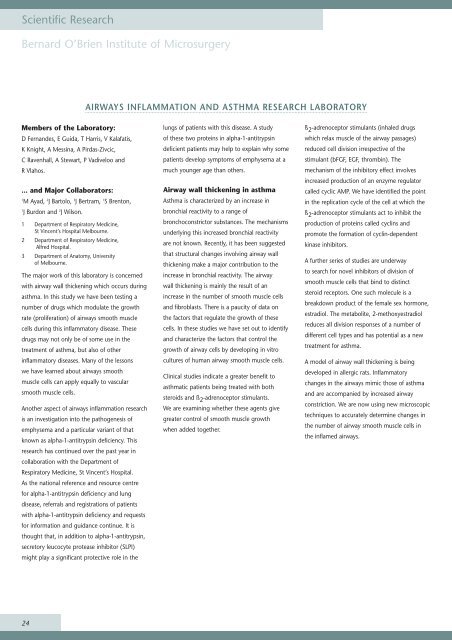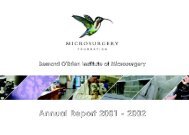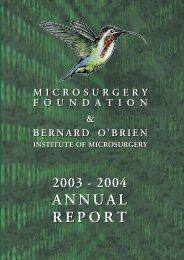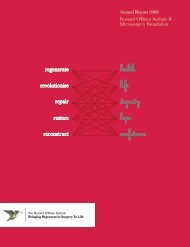2990 Microsurgery.qxd - O'Brien Institute
2990 Microsurgery.qxd - O'Brien Institute
2990 Microsurgery.qxd - O'Brien Institute
Create successful ePaper yourself
Turn your PDF publications into a flip-book with our unique Google optimized e-Paper software.
Scientific Research<br />
Bernard O’Brien <strong>Institute</strong> of <strong>Microsurgery</strong><br />
AIRWAYS INFLAMMATION AND ASTHMA RESEARCH LABORATORY<br />
Members of the Laboratory:<br />
D Fernandes, E Guida, T Harris, V Kalafatis,<br />
K Knight, A Messina, A Pirdas-Zivcic,<br />
C Ravenhall, A Stewart, P Vadiveloo and<br />
R Vlahos.<br />
... and Major Collaborators:<br />
1<br />
M Ayad, 2 J Bartolo, 3 J Bertram, 1 S Brenton,<br />
1<br />
J Burdon and 2 J Wilson.<br />
1 Department of Respiratory Medicine,<br />
St Vincent’s Hospital Melbourne.<br />
2 Department of Respiratory Medicine,<br />
Alfred Hospital.<br />
3 Department of Anatomy, University<br />
of Melbourne.<br />
The major work of this laboratory is concerned<br />
with airway wall thickening which occurs during<br />
asthma. In this study we have been testing a<br />
number of drugs which modulate the growth<br />
rate (proliferation) of airways smooth muscle<br />
cells during this inflammatory disease. These<br />
drugs may not only be of some use in the<br />
treatment of asthma, but also of other<br />
inflammatory diseases. Many of the lessons<br />
we have learned about airways smooth<br />
muscle cells can apply equally to vascular<br />
smooth muscle cells.<br />
Another aspect of airways inflammation research<br />
is an investigation into the pathogenesis of<br />
emphysema and a particular variant of that<br />
known as alpha-1-antitrypsin deficiency. This<br />
research has continued over the past year in<br />
collaboration with the Department of<br />
Respiratory Medicine, St Vincent’s Hospital.<br />
As the national reference and resource centre<br />
for alpha-1-antitrypsin deficiency and lung<br />
disease, referrals and registrations of patients<br />
with alpha-1-antitrypsin deficiency and requests<br />
for information and guidance continue. It is<br />
thought that, in addition to alpha-1-antitrypsin,<br />
secretory leucocyte protease inhibitor (SLPI)<br />
might play a significant protective role in the<br />
lungs of patients with this disease. A study<br />
of these two proteins in alpha-1-antitrypsin<br />
deficient patients may help to explain why some<br />
patients develop symptoms of emphysema at a<br />
much younger age than others.<br />
Airway wall thickening in asthma<br />
Asthma is characterized by an increase in<br />
bronchial reactivity to a range of<br />
bronchoconstrictor substances. The mechanisms<br />
underlying this increased bronchial reactivity<br />
are not known. Recently, it has been suggested<br />
that structural changes involving airway wall<br />
thickening make a major contribution to the<br />
increase in bronchial reactivity. The airway<br />
wall thickening is mainly the result of an<br />
increase in the number of smooth muscle cells<br />
and fibroblasts. There is a paucity of data on<br />
the factors that regulate the growth of these<br />
cells. In these studies we have set out to identify<br />
and characterize the factors that control the<br />
growth of airway cells by developing in vitro<br />
cultures of human airway smooth muscle cells.<br />
Clinical studies indicate a greater benefit to<br />
asthmatic patients being treated with both<br />
steroids and ß 2 -adrenoceptor stimulants.<br />
We are examining whether these agents give<br />
greater control of smooth muscle growth<br />
when added together.<br />
ß 2 -adrenoceptor stimulants (inhaled drugs<br />
which relax muscle of the airway passages)<br />
reduced cell division irrespective of the<br />
stimulant (bFGF, EGF, thrombin). The<br />
mechanism of the inhibitory effect involves<br />
increased production of an enzyme regulator<br />
called cyclic AMP. We have identified the point<br />
in the replication cycle of the cell at which the<br />
ß 2 -adrenoceptor stimulants act to inhibit the<br />
production of proteins called cyclins and<br />
promote the formation of cyclin-dependent<br />
kinase inhibitors.<br />
A further series of studies are underway<br />
to search for novel inhibitors of division of<br />
smooth muscle cells that bind to distinct<br />
steroid receptors. One such molecule is a<br />
breakdown product of the female sex hormone,<br />
estradiol. The metabolite, 2-methoxyestradiol<br />
reduces all division responses of a number of<br />
different cell types and has potential as a new<br />
treatment for asthma.<br />
A model of airway wall thickening is being<br />
developed in allergic rats. Inflammatory<br />
changes in the airways mimic those of asthma<br />
and are accompanied by increased airway<br />
constriction. We are now using new microscopic<br />
techniques to accurately determine changes in<br />
the number of airway smooth muscle cells in<br />
the inflamed airways.<br />
24






